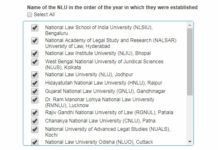 [Mr. Ashwin Julka, Partner at Remfry & Sagar, one of India’s oldest and foremost firms as well as a leader in Intellectual Property Rights, talks to CLATGyan’s Saachi Kapoor (Nalsar Class of 2016) about the industry, myriad facets of the profession, challenges, latest developments and just about everything interesting about lawyering.
[Mr. Ashwin Julka, Partner at Remfry & Sagar, one of India’s oldest and foremost firms as well as a leader in Intellectual Property Rights, talks to CLATGyan’s Saachi Kapoor (Nalsar Class of 2016) about the industry, myriad facets of the profession, challenges, latest developments and just about everything interesting about lawyering.
We are very grateful to Mr. Julka for taking time out of his very schedule to meet Saachi. He has candidly answered every question that I had framed for Saachi to shoot at him. Indeed, I must concede, that I was very apprehensive if he would share with us so much of professional information. “Sir, a big thank you!”
I also welcome aboard Saachi who shall be working with me on this section in CLATGyan from now on. ]
-Sandipan De.
1. What prompted your decision to take up law as a profession?
The time when Indian economic policy was poised on the brink of change was roughly the time when I graduated with a bachelor’s degree in economics. Times of flux are times of opportunity – the new economic regime demanded a plethora of new laws and regulations which lent the practice of law a very attractive, challenging sheen. I felt the profession would make for a very rewarding career and the years have fortunately not given me any reason to think otherwise.
2. Stepping stones in your career path… Mentors…
Remfry & Sagar was where I started my career and the fact that it was the largest IP firm in India at the time meant that I gained exposure to myriad facets of my chosen practice area – trade marks – within a relatively short span of time. A challenging work environment was complemented by the fact that the firm had developed some fine traditions whilst being at the helm of IP law for close to two centuries. A fair, non-family oriented, organisation structure, a healthy work life balance etc. made working at Remfry a very fulfilling experience. When I joined the firm, it was led by Dr. Vidya Sagar (he actively headed the firm as its Senior Partner until his passing in February 2011) – one of the sharpest and most determined minds in the legal profession that I have ever come across. I imbibed many finer nuances of legal practice from him. He was also an invaluable mentor to me in terms of honing my business management skills which are just as critical to developing a flourishing legal practice as specifically lawyerly attributes.
3. What according to you are the latest challenges to the IPR practice area / Latest developments in the IPR Sector…
Intellectual property laws protect and reward human creativity. Since human creativity knows no bounds, the intellectual property space is by definition extremely dynamic. Locating protection and enforcement mechanisms for emerging concepts within existing IP laws is quite challenging. But in the end, if one is successful in creating a precedent it is also extremely rewarding. For instance, the Internet age has required solutions to issues such as domain name conflicts and keyword advertising to be fashioned from extant principles of trade mark law. The proliferation of the Internet has also thrown up interesting challenges to established methods of locating jurisdiction.
Meanwhile, globalisation has driven the formulation of international standards of law and best practices. For IP law, the TRIPS Agreement is the definitive international treaty. India became a signatory in 1995 and had a ten year window to align its laws with the provisions of the said agreement. Thus, the 1995-2005 period saw a lot of legislation. Trade mark, patent and copyright law was heavily amended and hitherto unprotected IP subjects such as geographical indications, plant varieties etc. were brought under the ambit of protection by enacting fresh legislation. Today I can safely say that India offers some of the strongest IP protection there is in the world. However, lack of adequate manpower at the IP Offices and the clogged judicial system many a time challenge the effective enforcement of IP rights. Many initiatives are on to improve matters – complete digitization of records (accessible to all on the web) at the IP Offices and the growing judicial trend of awarding damages to discourage delay tactics and choke nuisance litigation being two examples. Thus, one can hope that a few years on challenges arising from administrative/judicial infrastructure will be few and far between.
4. Established in 1827, Remfry and Sagar has seen the entire legal arena develop to the present day scenario. How does a law firm adjust and accustom itself to changing laws and regulatory regimes.
The sheer longevity of the firm – it is arguably the second oldest IP firm in the world – implies that it has successfully weathered many a change since its establishment in 1827. The passage of time has institutionalised certain best practices in the firm, one of the most important ones being the emphasis on quality. This translates into a dynamic legal team which is well qualified, competent and at all times up to speed with changes and trends in IP law and policy. To illustrate, our patent team includes several people with post graduate degrees in technology to ensure comprehensive protection of our clients’ inventions. Publication of a newsletter every 3-4 months for internal and external circulation ensures that the knowledge base of employees and clients is augmented on a regular basis.
Remfry has also been prescient in anticipating trends – legal and otherwise. For instance, in the early 80’s, the firm was the first company in India to have a telex machine. It was also the first company to purchase a computer in India which now finds its place in the HCL Museum. Automation of records has meant that attorneys can devote valuable time to other tasks such as keeping up with all developments in the IP sphere.
When one is well-equipped with the tools of the trade, a change in status quo is always welcome. It makes for a more interesting day at the office and provides an opportunity to amplify the change through effective interpretation and implementation.
5. What has been the major challenge for Remfry, post-liberalisation of the Indian economy?
As I mentioned previously, there were several changes in IP law and policy between 1995 and 2005. Tackling a host of new concepts and procedures simultaneously has been a challenging task sometimes – particularly in the case of certain controversial provisions such as section 3(d) of the patent statute. In fact, acting for a global pharma major – Novartis – the firm posted the first challenge to the said section and in doing so was pitted against the entire domestic pharma industry.
Also, streamlining procedures vis-a-vis fresh principles has sometimes been fraught with problems at the IP Offices – which has made our job more arduous at times.
6. What exactly does your firm’s foray into Chinese jurisdictions entail and how is work different in China? Also how has the Chinese experience been in general?
In recent times India and China have shared a remarkable growth trajectory – they are among a select group of nations which are driving world growth even in the midst of strong recessionary currents. Geographically, they are neighbours and China is also India’s largest trading partner. All these factors translate into several shared interests and opportunities in all spheres including the law and more specifically the protection of IP rights.
Of course, being foreigners Indians cannot practice law in China. Remfry partnered closely with a Chinese firm with the shared objective of tapping into the large markets both countries have to offer by promoting the protection of Chinese IP interests in India and vice versa. A hands on presence in China meant that the firm could pick up on local nuances which can be quite critical to the success of any practice. Also it was interesting to note how China dealt with issues of counterfeiting, parallel imports etc. which are major concerns in India as well. So on the whole the Chinese experience has been a big value add.
7. Do you think that the academia is catering to industry needs or is there a gap between theory and practice as always?
Post 1991, the legal profession took off in a big way particularly in terms of the wide proliferation of corporate law firms/practices. There was suddenly a huge demand for young lawyers and for the most part the concomitant increase in law schools in the country has been able to satisfy industry requirements. However, one area where there continues to be a shortfall is that of patent attorneys. To practice patent law before the Indian Patent Office one must have a technical undergraduate degree and there is still a relative scarcity of such qualified individuals especially since most 5 year law curriculums do not provide this opportunity.
As to gaps between theory and practice, I believe the main purpose of a university education is to further the spirit of inquiry, perfect the art of research and presentation and acquire a thorough grounding in basic principles. Equipped with such attributes, an eager learner and hard worker should not have any trouble in acquiring the required additional skills once he/she enters the legal profession. Practical training workshops and internships provide a glimpse of more specialised skill sets to law students, however, specialisation in terms of course materials does not, in my opinion, need to top the agenda.
8. Do you think liberalisation of the Indian legal market is inevitable? If yes, how do you think Indian firms will meet the challenge?
The main concern of the Indian legal fraternity re liberalisation is the lack of reciprocity. Take for instance the jurisdictions of the US or EU – local qualifications are mandatory. However, an Indian bar examination was instituted last year and that may go some way in alleviating concerns on lack of awareness on local laws and regulations amongst foreign attorneys.
As I see it this subject is placed amongst a broader set of discussions on concessions between India and other nations. But one day or the next some foreign legal presence will be permitted – though it might be restricted to the dispensation of legal advice and prohibit appearance before judicial/quasi-judicial bodies.
The vast increase in the number of law firms has already made the Indian legal environment a very competitive space. If work content is the criteria, both employers and employees cannot complain on account of variety and volume. Salaries too seem to reflect international trends. However, many practices are still family run and lack the institutionalization of the large corporate firms which operate overseas. There are also a number of small breakaway firms. Such entities may find the going tough once foreign legal presence with international best practices becomes a reality in India.
9. As an employer, what do you potentially look at from a student passing out of law school?
Spirit of curiosity, level of awareness, desire to excel, communication abilities and inter-personal skills.
10. How has the legal world changed since you were admitted to the bar?
The opportunities in the Indian legal sphere have grown enormously. The size of legal practices has also scaled up considerably. The communication age has to a large extent harmonized laws and legal practice all over the globe. Yet certain basic things remain constant. At the end of the day one must understand, anticipate and meet the client’s needs. To that end, local nuances are very important.
11. A word for law school aspirants and present law school-ites…..
You are guaranteed a dynamic and fulfilling legal career in India in times to come.
12. Other than law….what are your other recreational activities? Work-life balance….or is that just elusive?
Juggling the various demands at office is sometimes taxing but ultimately has its recompense. My work entails quite a bit of travel – to meet clients, attend conferences etc. – and I feel constantly enriched by my interactions with people from different countries and cultures. Having said that, Remfry promotes a work-life balance very strongly with the belief that a happy, well-rounded employee is the most motivated and productive employee. So I try to lead by example and enjoy spending time with my family on the weekends. I am quite keen on my garden and sitting amongst greenery provides me much needed relaxation from pressures of work!















its really gud thanks for giving us a glimpse of legal wrld
No offense, but have you guys died or something?
Yes! We’ll get back our lives once our End Semester exams are over. (Which should be in a week or so)